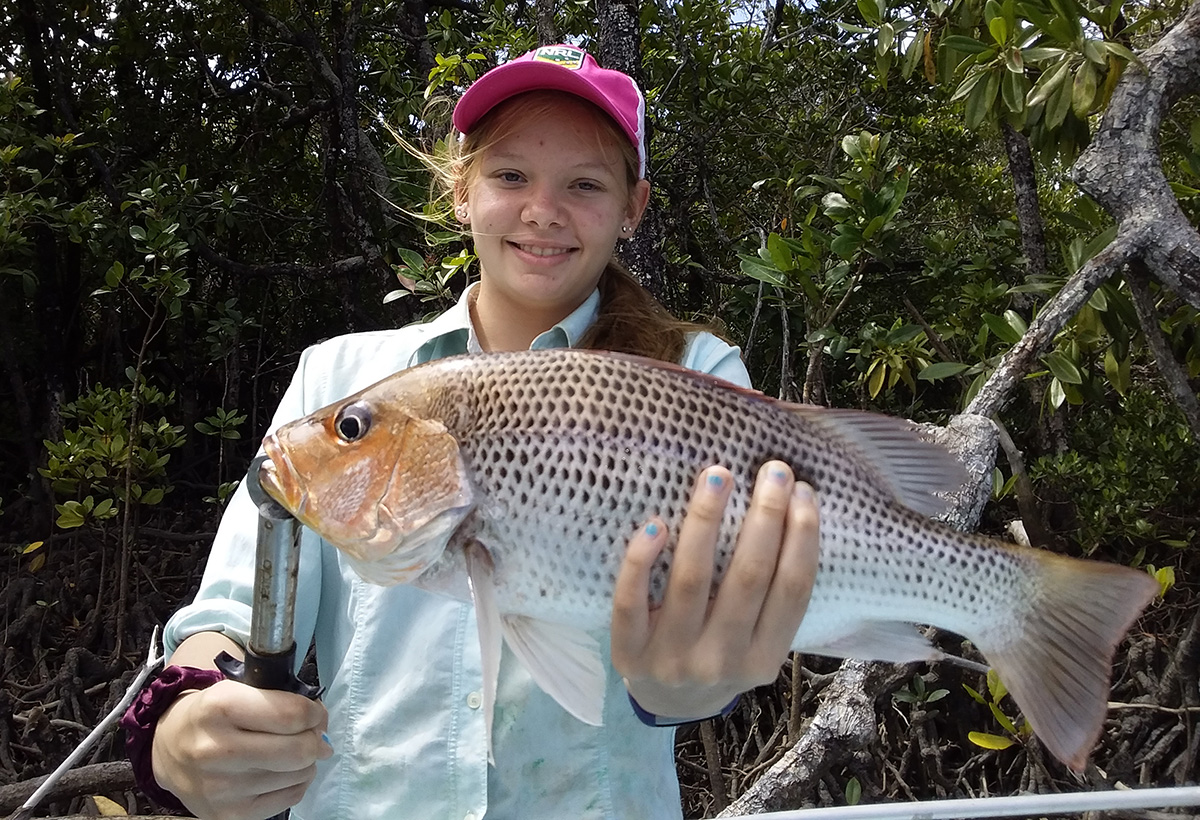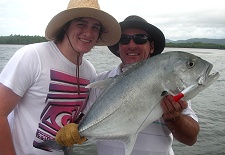River, Estuary and Coastal Fishing target species
River & Estuary Fishing
As with all fish species please check the fishing regulations in your local area for size and bag limits. It is your responsibility as an angler.
For more information visit www.qld.gov.au

Did you know?
- Iconic fish of the tropics
- Caught in all our rivers, creeks, estuary systems, beaches and headlands
- Most aggressive between the months of Sep to mid May
- Begin their lives as males and turn into females around the 65-75cm range
- Not allowed to fish during breeding season from Nov - Jan
- Variety of fishing methods with lure fishing and live bait fishing
- Are a challenging fish
- Considered a trophy fish
- Saltwater barramundi offer the better eating qualitites than brackish water species
Barramundi
This fish is the iconic fish of the tropics, which people travel vast distances to catch. Their beautiful silver flanks and aerial fighting capabilities are legendary. They are caught in all our rivers, creeks, estuary systems, beaches and headlands along our coastline. They are most aggressive between the months of September to mid May and go into a slumber during the coolest months. They must also be released between the start of November to the end of January during their breeding season. Barramundi begin their lives as males and turn into females around the 65-75cm range.
Barramundi are targeted in a variety of methods with lure fishing and live bait fishing being the most common. They are a challenging fish to engage and some expertise is necessary to be successful at capturing them. Once hooked they will jump to dislodge the hooks and are very efficient in achieving this. They also offer deep surging runs into snags presenting further challenges. Once caught though they are considered a trophy fish and catching one exceeding the one metre mark is considered by many as the equivalent of a 1000lb marlin.
The barramundi which reside predominantly in the salt water as opposed to the brackish water offer the better eating qualities. Minimum size 58cm - Maximum 120cm Australian East Coast.

Did you know?
- Highly regarded as the hardest hitting fish on our coastline
- Aggressive in nature and patrol their habitat with intent
- Caught all year round
- Methods used are live baiting, dead baiting and lure fishing
- Begin their lives in our river and estuaries
- Grow up to 55cm before heading offshore
Mangrove Jack
This species is highly regarded as the hardest hitting fish on our coastline. They are very aggressive in nature and patrol their habitat with intent. They are caught all year round and turn up the heat in the warmer months. They are caught live baiting, dead baiting and lure fishing and tend to be found around structures such as fallen trees, submerged logs, rock walls and mangrove edges.
They begin their lives in our river and estuaries and grow up to 55cm before heading offshore to live on our outer reefs and become a prized reef species where their mean demeanour only grows in stature.
Their eating qualities are considered by many to be the best product available in our rivers and estuaries.

Did you know?
- Same family as the Mangrove Jack
- Known as golden snapper in northern parts
- Caught all year round, increase in the warmer months
- Rated very highly for their eating and fighting abilities
- Tend to live in deeper holes and channels in our rivers
- Best targeted using live bait between the change of the tides or on neap tides
- Extremely slow growing fish
- Flesh is sweet and considered a delicacy
Fingermark
Also known as golden snapper in northern parts, these fish are rated very highly for their eating and fighting abilities. Being from the same family as the mangrove jack they possess all the same quality attributes but do prefer slightly different habitats. They tend to prefer the deeper holes and channels in our rivers holding some form of structure and bait. They are best targeted using live bait presented close to their home.
Because they reside in the deeper water they are best targeted in between the change of the tides or on neap tides when the current is less. They have been known to venture into the shallows across the flats in search of food. As they grow larger they will head offshore and reside along our coastal headlands and inshore reefs. They can be caught all year round becoming more aggressive in the warmer months.
Fingermark are an extremely slow growing fish and take many years to reach maturity. Their flesh is sweet and firm and considered a delicacy. Minimum size 45cm.

Did you know?
- Highly sought after giant or talang queenfish
- Acrobatically spectacular to watch as they dance and cartwheel across the surface
- Caught all year round and can grow up to a powerful 12kg
- Variety of methods with live baiting, trolling lures and casting surface poppers as the most effective
- Travel up and down the coast and enter our systems on a rising tide
- Generally released
Queenfish
The highly sought after giant or talang queenfish is targeted for its sensational sporting attributes. Once hooked they are acrobatically spectacular to watch as they dance and cartwheel across the surface. The bigger models up to one metre and more will also offer powerful runs on top of the aerial stunts. They can be caught all year round and can grow up to a powerful 12kg.
They travel up and down the coast and enter our systems on a rising tide sometimes travelling miles upstream. They will also tend to congregate along headlands and inshore islands where bait schools gather. They swim with intent and speed looking to run down any prey in their wake. They can be targeted by a variety of methods with live baiting, trolling lures and casting surface poppers as the most effective.
They are considered purely as a sportfish and are generally released. Minimum size 50cm.

Did you know?
- Enter our rivers and creeks on rising tides
- Are caught most effectively using live bait, or casting smaller lures, poppers or saltwater flies
- Present all year round but do prefer cleaner water conditions
- Golden trevally are the only species worth keeping for consumption
Trevally
On rising tides these fish enter our rivers and creeks in schools and are mainly the juvenile to the medium models, however bigger species will venture in as well at various times. They will travel for miles upstream at can take up residency in deeper holes at times for a short period. They like to feed on small bait schools and can create quite a frenzy when they attack as a group.
They are caught most effectively using live bait, or casting smaller lures, poppers or saltwater flies. They are present all year round but do prefer cleaner conditions as they rely heavily on sight to ambush their prey.
There are a variety of species which reside along our coastline with giant trevally and golden trevally being a couple of the more common known species. Golden trevally are the only species worth keeping for consumption.

Did you know?
- Known as grunter
- Less known but superb fish to catch and consume
- Prefer river entrances and mangrove flats along the coast and upstream
- Best caught using live bait or fresh dead bait
- Can grow up to 55cm
- Excellent eating qualities
Javelin Fish (large spotted)
Also locally known as grunter, these fish seem to go under the radar but the reality is they are a superb fish to catch and consume. They seem to prefer river entrances and mangrove flats along the coast and also further upstream. They are best targeted in these shallow waters on a rising tide and during low light periods.
They can be caught using live bait or fresh dead baits. They can grow up to 55cm plus and at this size are a worthy adversary on the end of the line. Their eating qualities are excellent. Minimum size 40cm.


